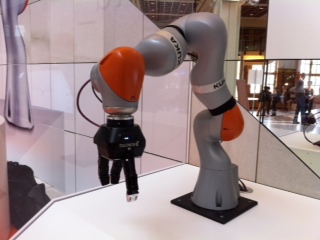Collaborative Robot Series : KUKA's Light Weight Robot 4+

Posted on May 16, 2013 in Collaborative Robots
4 min read time
To continue the collaborative robot series: this time we look at the Light Weight Robot 4+ (LWR 4+) from KUKA.
LWR 4+ : An Introduction
Kuka has targeted the needs of emerging clients by developing the solution of a flexible and sensitive robot : the LWR 4+.

Their new product’s housing is entirely enclosed and made of aluminium. It contains all the necessary components; such as motors, wires and sensors. This arm has 7 degrees of freedom which gives the LWR 4+ greater flexibility and precision than the more common 6-axis robots. It also has a payload capacity of 7 kg.
LWR 4+ : Key Features
-
Kuka highlights that the LWR 4+ is very responsive due to its integrated sensors. Since they are not situated in the end effector, but in the robot itself, simple tools can be use for any task.
-
Its weight (about 16 kg) makes the robot portable. LWR 4+ also has a low power consumption rate which allows it to be powered by batteries.
-
The robot can also be programmed by hand moving it. This along with its 7-axises, means that it can easily reach any point within its work zone. It also retains its position during programming, so, Kuka affirms that programming their LWR 4+ is very intuitive and efficient.
-
Its rounded shape contains no sharp edges that could be harmful to a human working beside it. Since it is a collaborative robot, its sensors detect external forces made by an obstacle or a human. These sensors are also independent from each other. These characteristics make the LWR a safe working partner, either for feeding human workers pieces or holding them while your employees work on it.
See the following video of human-robot collaboration with the Kuka LWR 4+
LWR 4+ : Challenges
Kuka Robotics has the same objective as other collaborative robotic companies, they want to make robots accessible for any shop floor. To achieve this goal, they offer a low cost product with a lot of flexibility. Since small companies often deal with small batches and many different products, this flexibility allows the robot to be assign to a different task and place in a short amount of time.
As mentioned above, the multiple sensors in the LWR 4+ make it safe for a human to work with, however, in case of a sensor failure, safety cannot be assured. Kuka wants to improve this aspect of its robot by detecting collisions and reacting to them with improved safety technology. Their PHRIENDS project has already given good results with a new safety strategy using virtual walls.
Kuka was at the ICRA in May 2013, where they were demonstrating their LWR 4+ robot using our 3-Finger Adaptive Robot Gripper. There are many reasons why our industrial electric grippers mesh well with the LWR 4+. For more information about the integration of the LWR 4+ using our hand, take a look at the article : The Right Gripper for the Kuka Lightweight Robot (LWR).
Also at ICRA, Kuka also has released the new LWR 4+ more oriented for industrial applications. Stay tuned to learn more about this new generation of the Lightweight robot.
Related articles on collaborative robots
Interested in related articles on collaborative robots read about:







Leave a comment